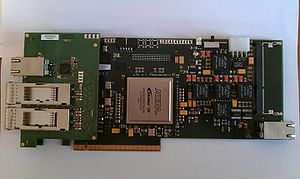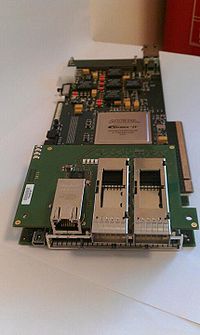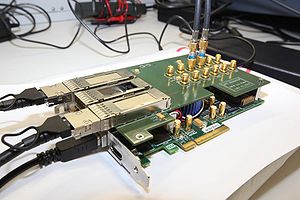Difference between revisions of "APEnet+ project"
| Line 1: | Line 1: | ||
| − | '''APEnet+''' is the new generation of our 3D network | + | '''APEnet+''' is the new generation of our 3D network adapters for PC clusters. |
| − | adapters for PC clusters. | ||
| − | |||
| − | |||
| − | |||
| + | [[Image:Apenet+_2.jpg |border|300px|right|thumb|APEnet+ board, front view]] | ||
==Project Background== | ==Project Background== | ||
| Line 16: | Line 13: | ||
via some parallel programming model, mainly Message Passing | via some parallel programming model, mainly Message Passing | ||
Interface (MPI). | Interface (MPI). | ||
| + | |||
| + | [[Image:Apenet+_1.jpg |border|200px|right|thumb|APEnet+ board, 3D Torus network cable connectors]] | ||
| + | [[Image:ApenetPlus_Board.jpg |border|300px|right|thumb|APEnet+ 3 links test board, based on a commercial development board]] | ||
==APEnet+ aim and features== | ==APEnet+ aim and features== | ||
| Line 35: | Line 35: | ||
* Fault-tolerance features (will be added from 2011). | * Fault-tolerance features (will be added from 2011). | ||
| − | |||
=== GPU Cluster installation === | === GPU Cluster installation === | ||
Revision as of 13:30, 7 February 2012
APEnet+ is the new generation of our 3D network adapters for PC clusters.
Project Background
Many scientific computations need multi-node parallelism for matching up both space (memory) and time (speed) ever-increasing requirements. The use of GPUs as accelerators introduces yet another level of complexity for the programmer and may potentially result in large overheads due to bookkeeping of memory buffers. Additionally, top-notch problems may easily employ more than a PetaFlops of sustained computing power, requiring thousands of GPUs orchestrated via some parallel programming model, mainly Message Passing Interface (MPI).
APEnet+ aim and features
The project target is the development of a low latency, high bandwidth direct network, supporting state-of-the-art wire speeds and PCIe X8 gen2 while improving the price/performance ratio on scaling the cluster size. The network interface provides hardware support for the RDMA programming model. A Linux kernel driver, a set of low-level RDMA APIs and an OpenMPI library driver are available; this allows for painless porting of standard applications.
Highlights
- APEnet+ is a packet-based direct network of point-to-point links with 2D/3D toroidal topology.
- Packets have a fixed size envelope (header+footer) and are auto-routed to their final destinations according to wormhole dimension-ordered static routing, with dead-lock avoidance.
- Error detection is implemented via CRC at packet level.
- Basic RDMA capabilities, PUT and GET, are implemented at the firmware level.
- Fault-tolerance features (will be added from 2011).
GPU Cluster installation
- Where: APE lab (INFN Roma 1)
- What: GPUcluster
APEnet+ Public Documentation
Internal links (require login):
APEnet+ HW, APEnet+ SW, APEnet+ specification, Next Deadlines For Pubblication


